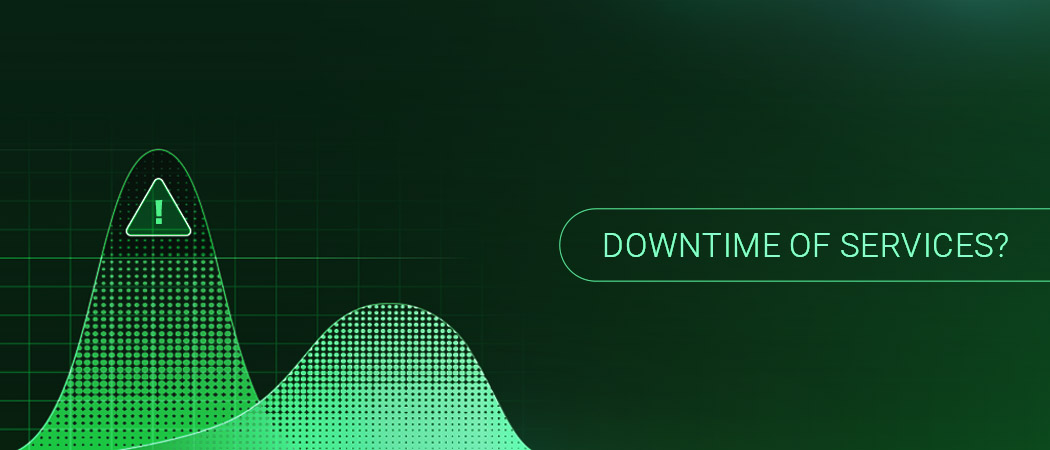Stop the Standstill: how Greenbone Helps Protect Against DoS Attacks
A DoS attack (Denial of Service) can mean a complete standstill: an important service fails, an application no longer responds or access to one’s own system is blocked. DoS attacks have a clear, destructive goal: to paralyze digital resources, preventing access to the legitimate users. The consequences of a DoS attack can be drastic: from downtime and business interruptions to financial losses and significant risks for the entire organization.

For several years, DoS attacks have been on the rise and have significantly impacted business, critical infrastructure and healthcare services. DoS attacks are also being leveraged in sophisticated cyber military campaigns and to extort victims into paying a ransom. What lies behind these attacks and how can you protect yourself?
Widening the Threat Landscape
With unauthorized access attackers may impose DoS by simply shutting down a system [T1529]. Otherwise, application logic flaws can allow a remote attacker to crash the system, or they may flood it with network traffic to exhaust its resources. Blocking account access [T1531], destroying data [T1485], or deploying ransomware [T1486] can further hinder system recovery [T1490] or distract defenders while other attacks take place. At the same time, disabled critical services increase vulnerability to further cyber attacks; if a virus scanner is stopped, malware can enter the network unimpeded; if backup services are down, full recovery from ransomware may be impossible.
DoS Attacks Often Leverage Known Weaknesses
DoS attacks often exploit weaknesses in network protocol specifications, improper protocol implementations, faulty logic in software applications, or misconfigurations. Some software flaws that could allow DoS attacks include:
- Uncontrolled resource consumption
- Buffer overflows
- Memory leaks
- Improper error handling
- Asymmetric resource consumption (amplification)
- Failure to release a resource after use
When vulnerabilities such as these are discovered, vendors rush to issue patches. However, only users who install them are protected. By scanning network and host attack surfaces, IT security teams can be alerted to DoS and other types of vulnerabilities. Once alerted, defenders can act by applying updates or adjusting vulnerable configurations.
Types of DoS Attacks
DoS attacks may employ a variety of different techniques, such as flooding networks with excessive traffic, exploiting software vulnerabilities, or manipulating application-level functions. Understanding how DoS attacks work and their potential impact is crucial for organizations to develop comprehensive defense strategies and minimize the risk of such disruptions.
The main categories of DoS attacks include:
- Volume Based DoS Attacks: Volume-based DoS attacks overwhelm the target’s network bandwidth or compute resources such as CPU and RAM with high volumes of traffic, rendering the network unable to fulfill its legitimate purpose.
- Application and Protocol DoS Attacks: These attacks target vulnerabilities within software applications or network protocols, which may reside at any layer of the protocol stack. Attackers exploit flaws in a protocol specification, flawed application logic, or system configurations to destabilize or crash the target.
- Amplification DoS Attacks: Amplification attacks exploit specific protocols that generate a response larger than the initial request. Attackers send small queries to the target which responds with large packets. This tactic significantly amplifies the impact to the victim as high as 100 times the initial request size.
- Reflection DoS Attacks: The attacker sends a request to a service, but replaces the source IP address with the victim’s IP. The server then sends its response to the victim, “reflecting” the attacker’s forged requests. Reflection attacks typically rely on UDP (User Datagram Protocol) due to its connectionless nature. Unlike TCP, UDP-based services do not automatically verify the source IP address of data they receive.
- Distributed DoS Attacks (DDoS): DDoS attacks leverage large groups of compromised devices (often called a botnet) to send overwhelming amounts of traffic to a target. Botnets consist of hacked web servers or SOHO (Small Office, Home Office) routers from all over the world and are controlled centrally by the threat actor. The distributed nature of DDoS attacks make them much harder to mitigate, as the malicious traffic comes from many different IP addresses. This makes it difficult to distinguish legitimate users and infeasible to block the botnet’s large number of unique IP addresses.
Using Greenbone Against System Breakdown
Government cybersecurity agencies from all NATO countries such as Germany, the US, and Canada urge vulnerability management as a top priority for defending against DoS attacks. By scanning for known vulnerabilities, Greenbone helps close the door to DoS attacks and can identify when human error contributes to the problem by detecting known misconfigurations and CIS benchmark controls. Greenbone also updates its vulnerability tests daily to include detection for the latest vulnerabilities that can allow successful DoS attacks.
Greenbone includes the Denial of Service category of vulnerability tests and other test families also include DoS identification such as: database DoS tests, web application DoS tests, web server DoS tests, Windows DoS tests [1][2] and product specific DoS detection for many enterprise networking products such as Cisco, F5, Juniper Networks, Palo Alto and more. Using Greenbone to scan your networks and endpoints, you have access to over 4,900 tests capable of identifying exploitable DoS flaws.
Also, when Greenbone’s “Safe Checks” protection for a scan configuration is disabled, our scanner will conduct active attacks such as amplification DoS attacks. Since these tests present higher risk such as increased likelihood of service disruption, the Safe Checks feature is enabled by default, meaning this extended set of invasive scans are not conducted unless specifically configured to do so.
While no known cybersecurity mitigation can guarantee protection against all DoS attacks such as high volume DDoS attacks, the proactive identification and mitigation of known flaws removes the “low-hanging fruit” presented by exploitable services. By removing known vulnerabilities from its IT infrastructure, an organization can avoid becoming part of the problem as well – since hijacked IT assets are often used by attackers to conduct DDoS attacks against others.
Summary
Denial of Service (DoS) attacks aim to disrupt the availability of IT systems by overwhelming them with traffic or by exploiting known software vulnerabilities. Greenbone’s comprehensive vulnerability assessment solutions can identify potential entry points for DoS attacks, enabling organizations to strengthen their defenses and minimize their risk. By proactively managing vulnerabilities and employing continuous monitoring, Greenbone helps organizations to detect and mitigate the impact of potentially destructive DoS attacks.



